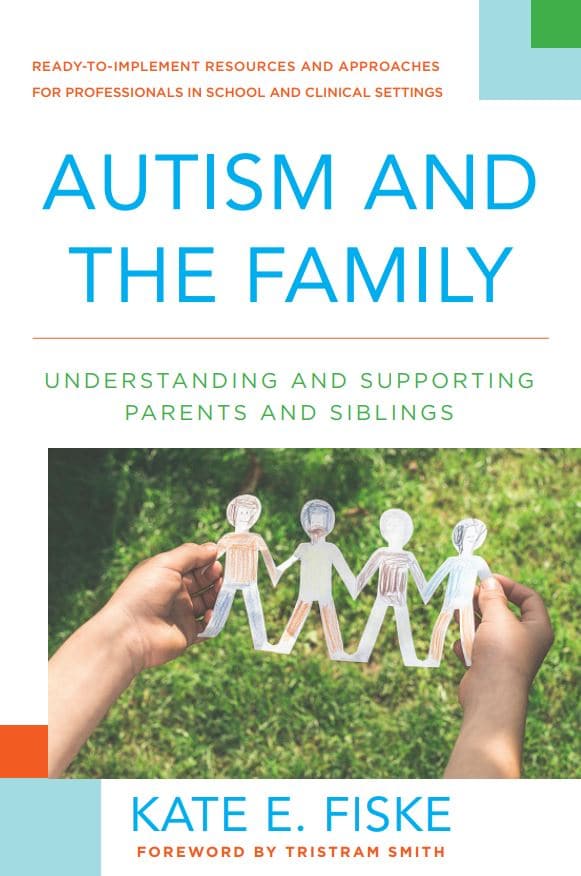Fiske, K. E. (2017). Autism and the family: Understanding and supporting families and siblings. New York, NY: W. W. Norton & Company, Inc.
Reviewed by
David Celiberti, PhD, BCBA-D and May Chrisline Beaubrun, MEd, BCBA
Association for Science in Autism Treatment

Autism and the Family
The critical role of the family cannot be understated when providing services to individuals with autism. It is thus unfortunate when new service providers fail to understand the effect autism has on both family members and the family as a whole. On the other hand, those able to understand autism from a broader systems perspective, and do so from a place of experience and empathy, can be well positioned to meet the myriad needs of not just parents but grandparents, siblings, other caregivers, and extended family members as well. In a related vein, lease see our recent article review related to compassion.
We are delighted to review Autism and the family: Understanding and supporting families and siblings authored by Dr. Kate Fiske. This book is an essential resource for professionals who provide services to individuals with autism and/or their families as it is researched-based and replete with the perspectives of family members. We applaud Dr. Fiske for thoughtfully tackling many complex, yet critically important, topics such as:
- Understanding the diagnosis itself, the process of diagnosis, and its implications
- Recognizing patterns of parent stress over time including shifts over time
- Appreciating the effects of ASD on parents, their relationships, and their careers
- Providing support for siblings and understanding impact on family and peer relationships
- Integrating extended family in care and treatment, as well as when extended family members are primary caregivers
- Understanding a family’s culture and the impact that culture has on access to services and perception of the diagnosis
- Identifying key coping strategies and managing crises
- Building a strong rapport with parents
- Guiding parents in the treatment of autism including how to advocate for their child
Each chapter reflects her rich clinical experience and expertise and integrates relevant research when appropriate. Chapters are well conceptualized so that one could either read the text cover to cover or use the book as a resource and delve deeper into pertinent topics (e.g., helping a family cope with the diagnosis or relationship building between parents and professionals). Furthermore, abundant, yet carefully placed, quotes of family members are included throughout the book to contextualize and humanize the impact of autism on the entire family. This is particularly important as many books written by professionals about families often fail to capture the unique perspective of the family members themselves and may come across as pedantic and condescending.
Perhaps, most importantly, Dr. Fiske ends each chapter with key clinical take-aways to better understand and support families within treatment delivery. These chapter-specific guidelines for practitioners to follow capture the essential messages associated with each chapter. The provided guidelines can be used when training staff to work with families, as a tool for practitioners to help ensure a high quality of service, or as an important reminder to broaden their perspective.
Dr. Fiske concludes her book with “call to action” that highlights how professionals can utilize the book to access all the recommendations to not only treat a child with autism spectrum disorder, but also to support the parents, siblings and extended family members as well. The entire book serves as a valuable resource to help identify goals and establish priorities.
Towards the end of the book, the author provides a resources section offering both general and family related materials as well as specific areas such as assessment and diagnosis, special education rights and services, safety, and transition to adulthood (adulthood is the one area that we wish was addressed more extensively in the book). Each resource provides online options as well as books. Practitioners can share these resources routinely with parent or practitioners or keep these lists available for parents as supplemental resources when and where suitable.
The foreword to this book was authored by Dr. Tris Smith who sadly passed away in August of 2018. Dr. Smith was a highly regarded member of ASAT’s Board of Directors for over 12 years. It was a privilege to be able to hear his frank views of this important subject matter. Dr. Smith made several important points in his foreword that are worthy of mention here: 1) There exists a void in the research and clear guidelines on how best to collaborate with families which is compounded by the reality that families who participate in research may not be representative of families served clinically; 2) There also exists a training gap to prepare providers across disciplines with the tools to communicate well with families to maximize both satisfaction with services and overall treatment outcome; 3) Resources such as Autism and the family: Understanding and supporting families and siblings are sorely needed.
In summary, professionals will be able to easily apply the information with families because of the thorough explanations and examples and be better positioned to approach their work delivering high quality intervention with understanding and empathy. We imagine that this book can also be both validating and illuminating for family members as well. Readers, both parents and professionals, will find the book engaging, comprehensive, and well organized.
Citation for this article:
Celiberti, D., & Beaubrun, M. (2019). [Review of the book Autism and the family: Understanding and supporting families and siblings, by K. Fiske]. Science in Autism Treatment, 16(7).
#MedicalProviders #SocialWorkers

